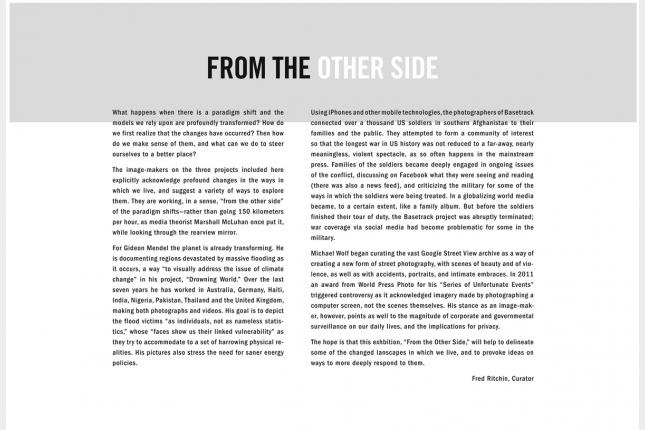03

What happens when there is a paradigm shift and the models we rely upon are profoundly transformed? How do we first realize that the changes have occurred? Then how do we make sense of them, and what can we do to steer ourselves to a better place?
The image-makers on the three projects included here explicitly acknowledge profound changes in the ways in which we live, and suggest a variety of ways to explore them. They are working, in a sense, “from the other side” of the paradigm shifts—rather than going 150 kilometers per hour, as media theorist Marshall McLuhan once put it, while looking through the rearview mirror.
For Gideon Mendel the planet is already transforming. He is documenting regions devastated by massive flooding as it occurs, a way “to visually address the issue of climate change” in his project, “Drowning World.” Over the last seven years he has worked in Australia, Germany, Haiti, India, Nigeria, Pakistan, Thailand and the United Kingdom, making both photographs and videos. His goal is to depict the flood victims “as individuals, not as nameless statistics,” whose “faces show us their linked vulnerability” as they try to accommodate to a set of harrowing physical realities. His pictures also stress the need for saner energy policies.
Using iPhones and other mobile technologies, the photographers of Basetrack connected over a thousand US soldiers in southern Afghanistan to their families and the public. They attempted to form a community of interest so that the longest war in US history was not reduced to a far-away, nearly meaningless, violent spectacle, as so often happens in the mainstream press. Families of the soldiers became deeply engaged in ongoing issues of the conflict, discussing on Facebook what they were seeing and reading (there was also a news feed), and criticizing the military for some
of the ways in which the soldiers were being treated. In a globalizing world media became, to a certain extent, like a family album. But before the soldiers finished their tour of duty, the Basetrack project was abruptly terminated; war coverage via social media had become problematic for some in the military.
Michael Wolf began curating the vast Google Street View archive as a way of creating a new form of street photography, with scenes of beauty and of violence, as well as with accidents, portraits, and intimate embraces. In 2011 an award from World Press Photo for his “Series of Unfortunate Events” triggered controversy as it acknowledged imagery made by photographing a computer screen, not the scenes themselves. His stance as an image-maker, however, points as well to the magnitude of corporate and governmental surveillance on our daily lives, and the implications for privacy.
The hope is that this exhbition, “From the Other Side,” will help to delineate some of the changed lanscapes in which we live, and to provoke ideas on ways to more deeply respond to them.
Fred Ritchin, Curator








